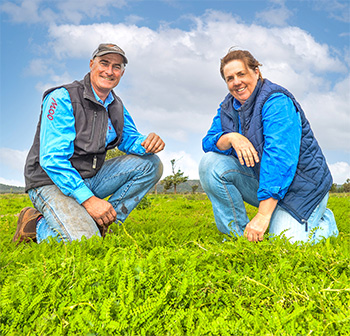Northern: Committed growers support hardy pasture legume revolution
Northern: Committed growers support hardy pasture legume revolution
Date: 04 Jul 2022

Identification and development of novel hard-seeded pasture legumes teamed with cost-reducing management practices and dedicated extension efforts are heralding a revolutionary change for growers in New South Wales’ low to medium-rainfall regions.
The Dryland Legume Pasture Systems (DLPS) project worked for five years (2017–22) in four states to improve management and better quantify benefits for animal and crop production within mixed-farming systems.
The project was a co-investment from the Grains Research and Development Corporation (GRDC), the Australian Government Department of Agriculture, Water and the Environment (DAWE) as part of its Rural R&D for Profit program, Meat and Livestock Australia (MLA) and Australian Wool Innovation (AWI).
It supported legume pasture research at Murdoch University, the South Australian Research and Development Institute (SARDI), CSIRO, the Western Australian Department of Primary Industries and Regional Development (DPIRD), and New South Wales Department of Primary Industries (DPI).
The DLPS focused on aerial-seeded legume species, which can be harvested on-farm. Combined with twin or summer sowing, a small amount of seed can be established across the farm at minimal cost. These hard-seeded varieties provide ‘legumes on demand’ that regenerate from the seedbank in the soil after one or more years of cropping.
Lasting benefits of these novel species include increased agility in the choice of crop or pasture production and the production of a highly nutritious forage for livestock, with the potential to reduce methane and greenhouse gas emissions for meat and wool production systems.
These legumes also increase nitrogen fixation in the farming system, reduce the need for fertiliser inputs and boost grain yield and protein contents in following crops.
In the low to medium-rainfall regions of central and southern NSW, growers have been looking for more-productive pasture legumes to complement and – in some cases – replace lucerne and reduce the incidence of bloat in livestock.
The portfolio of species now includes serradella (Ornithopus spp.), biserrula (Biserrula pelecinus), bladder clover (Trifolium spumosum) and gland clover (Trifolium glanduliferum). A release of Trigonella balansae is also expected in coming years, which will complement annual medics on alkaline soils.
NSW DPI pasture agronomist Dr Belinda Hackney managed the northern research component of the DLPS, including on farm trials, demonstration strips and extension activities.
“Grower involvement in the DLPS was critical to its success,” Dr Hackney says.
“From representatives on the project steering committee to growers hosting trial and demonstration sites, their participation created a sense of ownership in the project and we learnt together and ground-truthed the results in paddocks as we went.
“Growers told us if management aspects would not work for them and we also actively surveyed growers as we went to identify needs and limitations.”
Dr Hackney encourages ‘testing before investing’ with the novel legume species.
“A great way for growers to identify which species perform best on their properties was to purchase small amounts of seed of several of the new varieties and establish small nursery paddocks.

“Favourable species can then be harvested with conventional headers and sown in other paddocks.”
With Dr Hackney’s support, Paul Sinderberry and Sarah Wrigley trialled several new legume species in test strips on their 11,000ha mixed-farming enterprise north of Condobolin.
“We were on the hunt for legume species that had less bloat risk for our cattle enterprise and set up trial strips of a number of species, including biserrula and serradella, which were known to have lower bloat risk,” Paul says.
“We found the trial strips a really valuable exercise as we saw what was best-adapted to our red sandy clay loams that have a pHCa of between 4.5 and 5.5 and low phosphorus.
“Although our annual rainfall is around 420mm we experienced several years of drought during the test time and we were amazed at the seed-set and regrowth of biserrula after drought.”
Paul has learnt from local growers how to best harvest biserrula on-farm and has expanded his biserrula area, mixing it with lucerne to reduce bloat risk, and is beginning to introduce it into his cropping sequences.
Overall, more than 5000 growers and consultants were reached through the NSW DPI extension program over the course of the DLPS.
“Over the life of the project 3500ha Fran2o, 20,000ha biserrula and 40,000ha of the aerial-seeding clovers were sown across the low to medium-rainfall region of NSW,” Dr Hackney said.
Dr Hackney says they have received many requests from growers for a production manual for these new species, which they are working on, with an anticipated release in early 2023.
An independent national survey of 400 mixed-farming growers in the low-rainfall zone was commissioned by CSIRO on behalf of the program. Results are still being collated but will quantify current levels of adoption (including DLPS impacts), as well as understand barriers and future drivers of adoption to direct further pasture development.
For more information, read the full article on GRDC’s Groundcover online, or view the Groundcover supplement Dryland pasture legumes, a new era for mixed farms.
Contact Details
Interviews
Stephen Loss, GRDC Senior Regional Manager South
stephen.loss@grdc.com.au
0408 412 453
Contact
Danielle Gault, GRDC Communications Manager
danielle.gault@grdc.com.au
0448 766 881
GRDC Project Code: UMU1805-001RMX,
